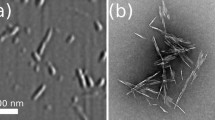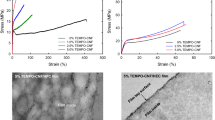Abstract
Regulation of pore defects is the critical technique for obtaining good performance of the cellulosic films. In this work, we have proved that the introduction of dimethyl sulfoxide into the new aqueous solvent system of tetrabutylammonium hydroxide can remarkably promote the dissolving capability of the natural cellulose. It is interesting to found that a suitable gelation during the aging process in preparing the cellulose films is very benefit for the mechanical performance of the prepared material. The relationship among process, structure and performance of the cellulose films has been researched. WAXD and FT-IR analysis have revealed the composition of cellulose II and IVII. The formed cellulose IVII with the structural characteristic of gel-like during the aging (gelation) process can serve as the uniform framework for heterogeneous regeneration of cellulose II, with which a cellulose films of network-like, good homogeneity and defect-free can be prepared. And synchronous enhancements of the tensile strength by 75% (from 78 to 137 MPa) and the elongation at break by 155% (from 4.63 to 11.80%) have been realized. The initial investigation in this work provides a sustainable approach to developing a facile process for high-performance materials from the natural cellulose.








Similar content being viewed by others
References
Abe M, Fukaya Y, Ohno H (2012) Fast and facile dissolution of cellulose with tetrabutylphosphonium hydroxide containing 40 wt% water. Chem Commun 48(12):1808–1810
Abe M, Kuroda K, Ohno H (2015) Maintenance-free cellulose solvents based on onium hydroxides. ACS Sustain Chem Eng 3(8):1771–1776
Andanson J-M, Bordes E, Devémy J, Leroux F, Pádua AAH, Gomes MFC (2014) Understanding the role of co-solvents in the dissolution of cellulose in ionic liquids. Green Chem 16:2528. https://doi.org/10.1039/c3gc42244e
Buleon A, Chanzy H (1978) Single crystals of cellulose II. J Polym Sci Polym Phys Ed 16:833–839
Cai J, Zhang L (2006) Unique gelation behavior of cellulose in NaOH/urea aqueous solution. Biomacromol 7(1):183–189
Chen X, Burger C, Fang D, Ruan D, Zhang L, Hsiao BS, Chu B (2006) X-ray studies of regenerated cellulose fibers wet spun from cotton linter pulp in NaOH/thiourea aqueous solutions. Polymer 47:2839–2848
Chen X, Burger C, Wan F, Zhang J, Rong L, Hsiao BS, Chu B, Cai J, Zhang L (2007) Structure study of cellulose fibers wet-spun from environmentally friendly NaOH/urea aqueous solutions. Biomacromol 8:1918–1926
Fink H-P, Ganster J, Lehmann A (2013) Progress in cellulose shaping: 20 years industrial case studies at Fraunhofer IAP. Cellulose 21(1):31–51. https://doi.org/10.1007/s10570-013-0137-7
French AD (2014) Idealized powder diffraction patterns for cellulose polymorphs. Cellulose 21(2):885–896
Gericke M, Liebert T, Seoud OAE, Heinze T (2011) Tailored media for homogeneous cellulose chemistry: ionic liquid/co-solvent mixtures. Macromol Mater Eng 296:483–493. https://doi.org/10.1002/mame.201000330
Guinier A, Fournet G (1955) Small-angle scattering of X-rays. Wiley, New York
Heinze T, Liebert T (2001) Unconventional methods in cellulose functionalization. Prog Polym Sci 26(9):1689–1762
Isogai A, Usuda M, Kato T, Uryu T, Atalla RH (1989) Solid-state CP/MAS 13C NMR study of cellulose polymorphs. Macromolecules 22:3168–3172
Kamel S (2008) Pharmaceutical significance of cellulose: a review. Express Polym Lett 2(11):758–778. https://doi.org/10.3144/expresspolymlett.2008.90
Klemm D, Heublein B, Fink HP, Bohn A (2005) Cellulose: fascinating biopolymer and sustainable raw material. Angew Chem Int Ed 44(22):3358–3393
Liu C-Y, Zhong G-J, Huang H-D, Li Z-M (2013) Phase assembly-induced transition of three dimensional nanofibril-to sheet-networks in porous cellulose with tunable properties. Cellulose 21:383–394
Liu Z, Sun X, Hao M, Huang C, Xue Z, Mu T (2015) Preparation and characterization of regenerated cellulose from ionic liquid using different methods. Carbohyd Polym 117:99–105. https://doi.org/10.1016/j.carbpol.2014.09.053
Ostlund A, Lundberg D, Nordstierna L, Holmberg K, Nyden M (2009) Dissolution and gelation of cellulose in TBAF/DMSO solutions: the roles of fluoride ions and water. Biomacromol 10:2401–2407
Östlund Å, Idström A, Olsson C, Larsson PT, Nordstierna L (2013) Modification of crystallinity and pore size distribution in coagulated cellulose films. Cellulose 20(4):1657–1667
O’sullivan AC (1997) Cellulose: the structure slowly unravels. Cellulose 4:173–207
Pinnow M, Fink H-P, Fanter C, Kunze J (2008) Characterization of highly porous materials from cellulose carbamate. Macromol Symp 262(1):129–139
Qi H, Cai J, Zhang L, Kuga S (2009) Properties of films composed of cellulose nanowhiskers and a cellulose matrix regenerated from alkali/urea solution. Biomacromol 10(6):1597–1602
Rinaldi R (2011) Instantaneous dissolution of cellulose in organic electrolyte solutions. Chem Commun (Camb) 47(1):511–513
Sahiner N, Singh M, De Kee D, John VT, McPherson GL (2006) Rheological characterization of a charged cationic hydrogel network across the gelation boundary. Polymer 47(4):1124–1131
Sinko R, Mishra S, Ruiz L, Brandis N, Keten S (2014) Dimensions of biological cellulose nanocrystals maximize fracture strength. ACS Macro Lett 3(1):64–69
Wang Y, Chen L (2011) Impacts of nanowhisker on formation kinetics and properties of all-cellulose composite gels. Carbohyd Polym 83(4):1937–1946
Wei W, Meng F, Cui Y, Jiang M, Zhou Z (2017) Room temperature dissolution of cellulose in tetra-butylammonium hydroxide aqueous solvent through adjustment of solvent amphiphilicity. Cellulose 24(1):49–59
Wu X, Moon RJ, Martini A (2014) Tensile strength of Iβ crystalline cellulose predicted by molecular dynamics simulation. Cellulose 21(4):2233–2245
Zhang L, Mao Y, Zhou J, Cai J (2005) Effects of coagulation conditions on the properties of regenerated cellulose films prepared in NaOH/urea aqueous solution. Ind Eng Chem Res 44(3):522–529
Zhao J, He X, Wang Y, Zhang W, Zhang X, Zhang X et al (2014) Reinforcement of all-cellulose nanocomposite films using native cellulose nanofibrils. Carbohyd Polym 104:143–150
Acknowledgments
This work is financially supported by the National Natural Science Foundation of China (No. 51303151) and the Science and Technology Planning Project of Sichuan Province (2015RZ0003, 2016GZ0222 and 2016GZ0229).
Author information
Authors and Affiliations
Corresponding authors
Electronic supplementary material
Below is the link to the electronic supplementary material.
Supplementary material 2 (3GP 12488 kb)
Supplementary material 3 (3GP 1292 kb)
Supplementary material 4 (3GP 13883 kb)
Rights and permissions
About this article
Cite this article
Cao, J., Wei, W., Gou, G. et al. Cellulose films from the aqueous DMSO/TBAH-system. Cellulose 25, 1975–1986 (2018). https://doi.org/10.1007/s10570-017-1639-5
Received:
Accepted:
Published:
Issue Date:
DOI: https://doi.org/10.1007/s10570-017-1639-5




